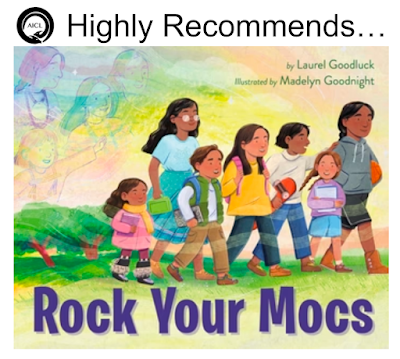- Home
- About AICL
- Contact
- Search
- Best Books
- Native Nonfiction
- Historical Fiction
- Subscribe
- "Not Recommended" books
- Who links to AICL?
- Are we "people of color"?
- Beta Readers
- Timeline: Foul Among the Good
- Photo Gallery: Native Writers & Illustrators
- Problematic Phrases
- Mexican American Studies
- Lecture/Workshop Fees
- Revised and Withdrawn
- Books that Reference Racist Classics
- The Red X on Book Covers
- Tips for Teachers: Developing Instructional Materials about American Indians
- Native? Or, not? A Resource List
- Resources: Boarding and Residential Schools
- Milestones: Indigenous Peoples in Children's Literature
- Banning of Native Voices/Books
- Debbie on Social Media
- 2024 American Indian Literature Award Medal Acceptance Speeches
- Native Removals in 2025 by US Government
Saturday, January 20, 2024
News! JUST LIKE GRANDMA written by Kim Rogers ...
Sunday, August 27, 2023
Highly Recommended: ROCK YOUR MOCS, written by Laurel Goodluck, illustrated by Madelyn Goodnight
A couple of years ago when I saw that Laurel Goodluck and Madelyn Goodnight were doing a picture book about Rock Your Mocs day, I was absolutely delighted! Turning that day into a picture book is brilliant! It is one way to show readers that Native peoples are people of tribal nations located across the continent, and that our names, languages, histories, stories, songs homes--and clothing--are unique.
Just look at that cover and you'll see another huge plus. Those are Native kids of the present day. The art is gorgeous, the idea is brilliant and the opportunity to know us for who we are: outstanding!
Goodluck's text is ebullient. Here's a look at the left-side of one page. "Indigenous Nations." "...in cities and towns..." and "We're stylin' today as we Rock Our Mocs!" All of that is terrific. And the decision to put "Rock Our Mocs" in a larger font size than the rest of the text works so well!
I adore what I see in Rock Your Mocs and recommend you get copies for your classroom and school library and that you consider getting one for your home library, too. And gift copies to friends!
HIGHLY RECOMMENDED: REZ BALL BY BYRON GRAVES
These days, Tre Brun is happiest when he is playing basketball on the Red Lake Reservation high school team—even though he can’t help but be constantly gut-punched with memories of his big brother, Jaxon, who died in an accident.
When Jaxon's former teammates on the varsity team offer to take Tre under their wing, he sees this as his shot to represent his Ojibwe rez all the way to their first state championship. This is the first step toward his dream of playing in the NBA, no matter how much the odds are stacked against him.
But stepping into his brother’s shoes as a star player means that Tre can’t mess up. Not on the court, not at school, and not with his new friend, gamer Khiana, who he is definitely not falling in love with.
After decades of rez teams almost making it, Tre needs to take his team to state. Because if he can live up to Jaxon's dreams, their story isn’t over yet.
Life of Native kids on reservations -- Byron Graves gives it to us straight. The joys and the tears... it is all here. As noted above, I highly recommend Rez Ball and I look forward to seeing what Byron Graves writes next!
Saturday, April 01, 2023
Highly Recommended! CONTENDERS: TWO NATIVE BASEBALL PLAYERS, ONE WORLD SERIES by Traci Sorell and Arigon Starr
The two players the book is about are Charles Albert Bender, who was Ojibwe and John Tortes Meyers, who was Cahuilla. Wait... I gotta say that when I came to the page about John's childhood, I leaned in. Why?
Tuesday, March 21, 2023
Highly Recommended: REMEMBER by Joy Harjo, illustrated by Michaela Goade
Remember your birth, how your motherstruggled to give you form and breath.You are evidence of her life,and her mother's, and hers.
Wednesday, March 15, 2023
Highly Recommended: HEART BERRY BLING by Jenny Kay Dupuis; illustrated by Eva Campbell
On a visit to her granny, Maggie is excited to begin her first-ever beading project: a pair of strawberry earrings. However, beading is much harder than she expected! As they work side by side, Granny shares how beading helped her persevere and stay connected to her Anishinaabe culture when she lost her Indian status, forcing her out of her home community—all because she married someone without status, something the men of her community could do freely.
As she learns about patience and perseverance from her granny’s teachings, Maggie discovers that beading is a journey, and like every journey, it’s easier with a loved one at her side.
In this beautifully illustrated book, children learn about the tradition of Anishinaabe beadwork, strawberry teachings, and gender discrimination in the Indian Act.
"That's me. Back when I lived on the reserve."
"I was stripped of my Indian status and had to leave the community."













